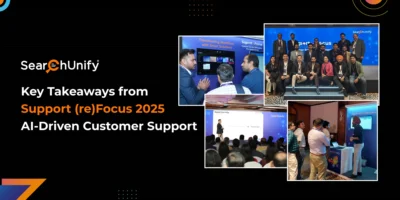
Did you know that 88% of people worldwide expect brands to offer customer support portals for self-service?
In today’s fast-paced world, self-service portals have become a cornerstone of staying competitive and meeting customer expectations. However, a poorly designed self-service portal can backfire, making it challenging for customers to find the answers they seek.
The results? A higher burden on support agents, which negatively impacts business ROI.
So. how can you turn a self-service portal into a case deflection engine?
Well, its success lies in the five design principles discussed in this blog post. Let’s dive in and learn how you can upgrade your customer self-service experience through the support portal.
5 Design Principles for Self-Service Portal Success
1. Website Simplicity: The Foundation of User-Friendly Design
What do customers expect when they visit a support portal? Easy navigation, top-notch search functionality, visible facets, and easy interaction, right? But if they don’t get it—they’ll leave the portal frustrated and dissatisfied, potentially eroding revenue.
80% of customers are likely to shift to a competitor after one bad customer experience.
This is where website simplicity comes into play. Offering a simple, intuitive digital experience reduces users’ cognitive load, makes finding information a breeze, and also increases customer retention rate.

2. Website Design: The Best Methodologies to Enhance Self-Service Experience
Websites should be simple yet effective. Therefore, Adopting the best website design methodologies is crucial to achieving these two. Here are some methodologies to build a self-service portal that not only looks good but also fosters a smoother experience.

3. Tailoring Personalized Self-Service: Understanding Your Users
Personalization is no longer a luxury; it’s an expectation. Even Forrester stated, 77% of consumers have chosen, recommended, or paid more for a brand that provides a personalized experience.
Imagine a self-service portal that not only caters to customer needs but also recommends personalized solutions. Sounds amazing, right? This approach would make customers feel valued and understood, increasing loyalty and advocacy for your brand.

4. Effective Content Strategy: Craft Content That Drives Self-Service
Having content on your customer self-service portal isn’t enough; it also needs to be easily digestible and solve customer queries effectively. Therefore, a well-thought-out content strategy is crucial to ensure customers get high-quality, accurate, and helpful content.
Here are some considerations:

Quality Over Quantity
Remember, every piece of content is an opportunity to provide value to your customers. Ensure all content is informative, accurate, and valuable, as it directly impacts customer satisfaction.
Step-by-Step Guides
Offering step-by-step instructions with clear visuals will guide users through complex tasks like resetting passwords or troubleshooting technical issues.
Glossary of Terms
Include a glossary that clarifies technical terms used within the portal, making content accessible to users of all technical backgrounds.
Structured Content
Organize content using headings, bullet points, and short paragraphs to make it easy to find and understand.
SEO Best Practices
Optimize content for search engines to enhance discoverability and accessibility.
5. AI Adoption Strategy: For Successful Self-service Experience
Envision a world where customers visit the support portal, get relevant information, and solve their queries quickly. It will reduce the influx of support tickets, ease overworked agents, and save millions.
Are you wondering how it is even possible? The answer lies in GenAI-powered solutions.
GenAI is transforming how businesses interact with customers, offering new ways to enhance customer self-service experience through a support portal.
Here’s how GenAI-powered solutions integration with your support portal will catapult you to the top:

Unified search from multiple repositories
It would eliminate the need to hop tabs of different platforms to search for the answers.
Contextually relevant answers
GenAI utilizes Natural Language Processing, which helps analyze the user’s query and understand its overall intent. It limits keyword-based searches to serve more contextual search results.
Query completion suggestion
Suppose a search reads your customers’ minds and shows suggestions after a few keystrokes to complete their queries. Pretty cool, right?
It saves time and creates a feeling that you understand your customers precisely what they want.
Personalized Recommendations
It analyzes 360-degree user behavior and search history and provides personalized recommendations for a better customer experience.
Tune Search Results
You can optimize your self-help portal by tuning search results based on popularity, keywords, content sources, etc.
Additionally, you can feature trending articles on the homepage and prioritize content based on user views to ensure your customers easily find the most relevant and engaging information.
Predictive Analytics
It provides search analytics that helps identify content gaps and eliminate the “no result” error. You can fetch a detailed report of Successful Searches, Popular Searches, Searches with No Results, etc., and utilize it to fill in the knowledge gaps and revolutionize your personalization strategy.
That’s not all! SearchUnify is a recognized leader among industry giants.
- SoftwareReviews has named SearchUnify a Leader in the Enterprise Search Quadrant Report.
- IDC Market recognizes SearchUnify as a Leader in the worldwide general-purpose knowledge discovery software
Want to level up your customer self-service experience?
As customer needs evolve continuously, a well-designed self-service portal powered by GenAI serves as a gateway for customers to access information. It solves their queries without calling support agents, giving the business a competitive edge.
Anyone can provide customer service, but offering an exceptional self-service experience that your customers value and remember is a tough nut to crack. But no worries—we can help!













